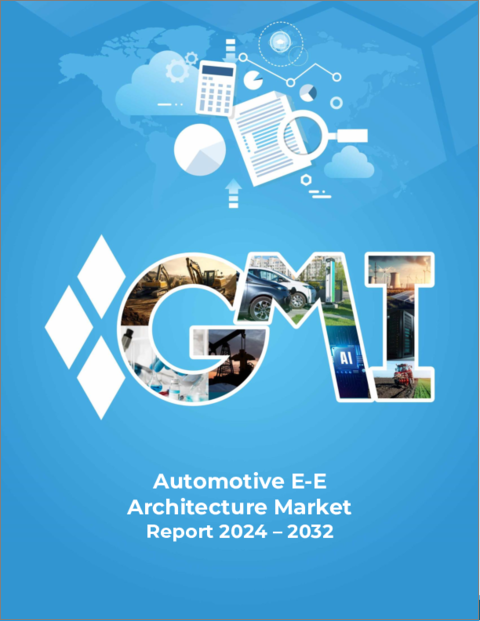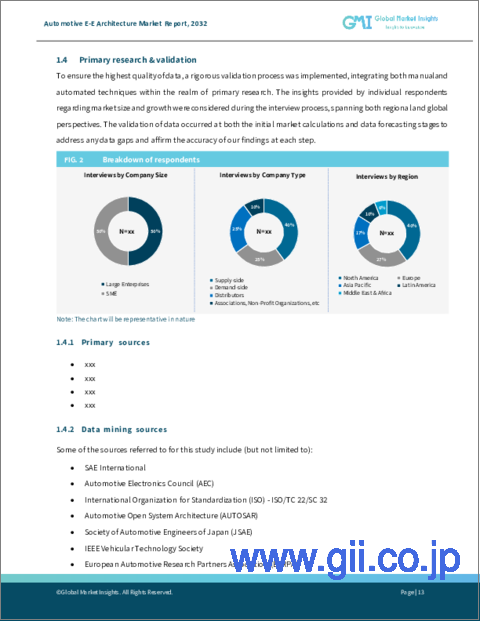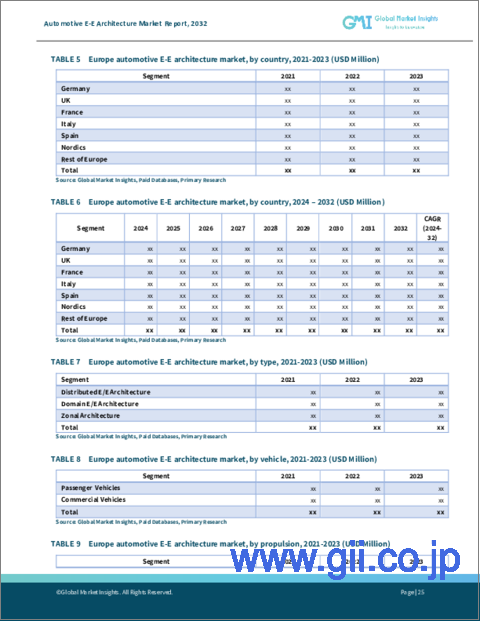|
|
市場調査レポート
商品コード
1638847
自動車E/Eアーキテクチャ市場の機会、成長促進要因、産業動向分析、2024年~2032年の予測Automotive E-E Architecture Market Opportunity, Growth Drivers, Industry Trend Analysis, and Forecast 2024 to 2032 |
||||||
カスタマイズ可能
|
|||||||
| 自動車E/Eアーキテクチャ市場の機会、成長促進要因、産業動向分析、2024年~2032年の予測 |
|
出版日: 2024年11月07日
発行: Global Market Insights Inc.
ページ情報: 英文 170 Pages
納期: 2~3営業日
|
- 全表示
- 概要
- 目次
世界の自動車E/Eアーキテクチャ市場は、2023年に752億米ドルに達し、2024年から2032年にかけてCAGR 8.5%で成長すると予測されています。
この成長の主な要因は、電気自動車(EV)の普及が進み、自動車の安全性と規制遵守が重視されるようになったことです。自動車産業が排出ガスと化石燃料への依存を減らすために電動化へと移行するにつれて、複雑で効率的なE/Eシステムの需要が急増しています。
安全規制が強化され、高度な安全機能に対する消費者の期待が高まっていることも、市場の拡大を後押ししています。ADAS(先進運転支援システム)などの最新の安全技術は、データを効率的に処理し、車両の性能を確保するために、堅牢なE/Eアーキテクチャに依存しています。これらのシステムは、車両の安全性を向上させ、自律走行機能などの将来の進歩の基盤となります。
市場は車両タイプ別に乗用車と商用車に区分されます。2023年には、乗用車が市場の大半を占め、収益シェアの75%以上を占め、2032年には1,000億米ドルを超えると予想されます。安全システム、コネクティビティ機能、インフォテインメント・ソリューションを含む先進技術の普及が、乗用車におけるE/Eアーキテクチャの成長を促進しています。消費者は利便性、快適性、安全性の向上をますます優先するようになっており、このセグメントでは高度な電子システムの統合が進んでいます。
| 市場範囲 | |
|---|---|
| 開始年 | 2023 |
| 予測年 | 2024-2032 |
| 開始金額 | 752億米ドル |
| 予測金額 | 1,533億米ドル |
| CAGR | 8.5% |
推進タイプ別に、市場は内燃機関車(ICE)と電気自動車に分けられます。2023年の市場シェアは内燃機関車(ICE)が上回ったが、成長率は電気自動車が上回っています。EVは、パワートレイン、バッテリーシステム、エネルギー分配ネットワークの管理が複雑なため、より高度なE/Eアーキテクチャが要求されます。さらに、排出削減政策やインセンティブなど、持続可能性を促進するための世界の取り組みがEVへのシフトを加速しており、高度な電子システムの需要をさらに押し上げています。
地域別では、中国が2023年の自動車用E/Eアーキテクチャ市場をリードし、売上高の60%を占めています。世界最大の自動車生産拠点である中国は、高度なE/Eシステムに大きく依存するEVを含む自動車の製造において極めて重要な役割を果たしています。政策、インセンティブ、補助金を通じた政府の強力な支援が中国の地位をさらに強化し、EV生産と自動車技術革新の成長を促進しています。
目次
第1章 調査手法と調査範囲
第2章 エグゼクティブサマリー
第3章 業界洞察
- エコシステム分析
- サプライヤーの状況
- E/Eアーキテクチャプロバイダー
- コンポーネントプロバイダー
- 流通業者
- エンドユーザー
- 利益率分析
- E/Eアーキテクチャコンポーネントの価格分析
- 技術とイノベーションの展望
- 主要ニュース&イニシアチブ
- 規制状況
- 影響要因
- 促進要因
- 電気自動車(EV)の需要拡大
- 自動車の安全性と規制基準への注目の高まり
- ADAS(先進運転支援システム)の採用増加
- コネクテッドカーとV2X(Vehicle-to-Everything)通信の需要。
- 業界の潜在的リスク&課題
- 先進E/Eアーキテクチャの開発の複雑さとコストの高さ
- 車両接続性の向上に伴うサイバーセキュリティリスク
- 促進要因
- 成長可能性分析
- ポーター分析
- PESTEL分析
第4章 競合情勢
- イントロダクション
- 企業シェア分析
- 競合のポジショニング・マトリックス
- 戦略展望マトリックス
第5章 市場推計・予測:タイプ別、2021年~2032年
- 主要動向
- 分散E/Eアーキテクチャ
- ドメインE/Eアーキテクチャ
- ゾーンアーキテクチャ
第6章 市場推計・予測:車両別、2021年~2032年
- 主要動向
- 乗用車
- ハッチバック
- セダン
- SUV車
- 商用車
- 小型商用車(LCV)
- 大型商用車(HCV)
第7章 市場推計・予測:推進別、2021年~2032年
- 主要動向
- ICE
- 電気自動車
- バッテリー電気自動車(BEV)
- プラグインハイブリッド車(PHEV)
- ハイブリッド電気自動車(HEV)
第8章 市場推計・予測:コンポーネント別、2021年~2032年
- 主要動向
- 電子制御ユニット(ECU)
- 配電ボックス
- アクチュエーターとセンサー
- 通信インターフェース
- ワイヤーハーネス
- その他
第9章 市場推計・予測:地域別、2021年~2032年
- 主要動向
- 北米
- 米国
- カナダ
- 欧州
- 英国
- ドイツ
- フランス
- スペイン
- イタリア
- ロシア
- 北欧
- アジア太平洋
- 中国
- インド
- 日本
- 韓国
- ニュージーランド
- 東南アジア
- ラテンアメリカ
- ブラジル
- メキシコ
- アルゼンチン
- 中東・アフリカ
- UAE
- 南アフリカ
- サウジアラビア
第10章 企業プロファイル
- Aptiv
- Continental
- Denso
- Faurecia S.A.
- Harman International
- Hitachi Astemo
- Hyundai Mobis
- Infineon Technologies
- Lear
- Magna International
- Marelli
- NXP Semiconductors
- Panasonic
- Renesas Electronics
- Robert Bosch
- STMicroelectronics
- Texas Instruments
- Valeo S.A.
- Visteon
- ZF Friedrichshafen
The Global Automotive E-E Architecture Market reached USD 75.2 billion in 2023 and is projected to grow at a CAGR of 8.5% from 2024 to 2032. This growth is primarily driven by the rising adoption of electric vehicles (EVs) and the increasing emphasis on vehicle safety and regulatory compliance. As the automotive industry transitions toward electrification to reduce emissions and fossil fuel dependency, the demand for complex and efficient E-E systems has surged.
Stricter safety regulations and heightened consumer expectations for advanced safety features fuels market expansion. Modern safety technologies, such as advanced driver assistance systems (ADAS), rely on robust E-E architectures to process data efficiently and ensure vehicle performance. These systems enhance vehicle safety and provide the foundation for future advancements, such as autonomous driving capabilities.
The market is segmented by vehicle type into passenger and commercial vehicles. In 2023, passenger vehicles dominated the market, accounting for over 75% of the revenue share, and are expected to surpass USD 100 billion by 2032. The widespread adoption of advanced technologies, including safety systems, connectivity features, and infotainment solutions, is driving the growth of E-E architecture in passenger vehicles. Consumers increasingly prioritize convenience, comfort, and enhanced safety, leading to greater integration of sophisticated electronic systems in this segment.
| Market Scope | |
|---|---|
| Start Year | 2023 |
| Forecast Year | 2024-2032 |
| Start Value | $75.2 Billion |
| Forecast Value | $153.3 Billion |
| CAGR | 8.5% |
By propulsion type, the market is divided into internal combustion engines (ICE) and electric vehicles. Although ICE vehicles held a larger share of the market in 2023, electric automotive are experiencing a faster growth rate. EVs demand more advanced E-E architectures due to the complexity of managing powertrains, battery systems, and energy distribution networks. Additionally, global efforts to promote sustainability, including emission reduction policies and incentives, are accelerating the shift toward EVs, further boosting demand for advanced electronic systems.
Regionally, China led the automotive E-E architecture market in 2023, contributing 60% of the revenue. As the world's largest automotive production hub, it plays a pivotal role in manufacturing vehicles, including EVs, which rely heavily on advanced E-E systems. Strong government support through policies, incentives, and subsidies has further strengthened China's position, fostering growth in EV production and automotive technological innovation.
Table of Contents
Chapter 1 Methodology & Scope
- 1.1 Research design
- 1.1.1 Research approach
- 1.1.2 Data collection methods
- 1.2 Base estimates and calculations
- 1.2.1 Base year calculation
- 1.2.2 Key trends for market estimates
- 1.3 Forecast model
- 1.4 Primary research & validation
- 1.4.1 Primary sources
- 1.4.2 Data mining sources
- 1.5 Market definitions
Chapter 2 Executive Summary
- 2.1 Industry synopsis, 2021 - 2032
Chapter 3 Industry Insights
- 3.1 Industry ecosystem analysis
- 3.2 Supplier landscape
- 3.2.1 E-E architecture providers
- 3.2.2 Component providers
- 3.2.3 Distributors
- 3.2.4 End-users
- 3.3 Profit margin analysis
- 3.4 Pricing analysis of E-E architecture components
- 3.5 Technology & innovation landscape
- 3.6 Key news & initiatives
- 3.7 Regulatory landscape
- 3.8 Impact forces
- 3.8.1 Growth drivers
- 3.8.1.1 Growing demand for electric vehicles (EVs)
- 3.8.1.2 Increasing focus on vehicle safety and regulatory standards
- 3.8.1.3 Rising adoption of advanced driver assistance systems (ADAS)
- 3.8.1.4 Demand for connected cars and vehicle-to-everything (V2X) communication
- 3.8.2 Industry pitfalls & challenges
- 3.8.2.1 High complexity and cost of developing advanced E/E architectures
- 3.8.2.2 Cybersecurity risks associated with increasing vehicle connectivity
- 3.8.1 Growth drivers
- 3.9 Growth potential analysis
- 3.10 Porter's analysis
- 3.11 PESTEL analysis
Chapter 4 Competitive Landscape, 2023
- 4.1 Introduction
- 4.2 Company market share analysis
- 4.3 Competitive positioning matrix
- 4.4 Strategic outlook matrix
Chapter 5 Market Estimates & Forecast, By Type, 2021 - 2032 ($Bn)
- 5.1 Key trends
- 5.2 Distributed E/E architecture
- 5.3 Domain E/E architecture
- 5.4 Zonal architecture
Chapter 6 Market Estimates & Forecast, By Vehicle, 2021 - 2032 ($Bn)
- 6.1 Key trends
- 6.2 Passenger vehicles
- 6.2.1 Hatchback
- 6.2.2 Sedan
- 6.2.3 SUV
- 6.3 Commercial vehicles
- 6.3.1 Light Commercial Vehicles (LCV)
- 6.3.2 Heavy Commercial Vehicles(HCV)
Chapter 7 Market Estimates & Forecast, By Propulsion, 2021 - 2032 ($Bn)
- 7.1 Key trends
- 7.2 ICE
- 7.3 Electric vehicles
- 7.3.1 Battery Electric Vehicles (BEV)
- 7.3.2 Plug-in Hybrid Electric Vehicles (PHEV)
- 7.3.3 Hybrid Electric Vehicles (HEV)
Chapter 8 Market Estimates & Forecast, By Component, 2021 - 2032 ($Bn)
- 8.1 Key trends
- 8.2 Electronic Control Units (ECUs)
- 8.3 Power distribution boxes
- 8.4 Actuators and sensors
- 8.5 Communication interfaces
- 8.6 Wiring harnesses
- 8.7 Others
Chapter 9 Market Estimates & Forecast, By Region, 2021 - 2032 ($Bn)
- 9.1 Key trends
- 9.2 North America
- 9.2.1 U.S.
- 9.2.2 Canada
- 9.3 Europe
- 9.3.1 UK
- 9.3.2 Germany
- 9.3.3 France
- 9.3.4 Spain
- 9.3.5 Italy
- 9.3.6 Russia
- 9.3.7 Nordics
- 9.4 Asia Pacific
- 9.4.1 China
- 9.4.2 India
- 9.4.3 Japan
- 9.4.4 South Korea
- 9.4.5 ANZ
- 9.4.6 Southeast Asia
- 9.5 Latin America
- 9.5.1 Brazil
- 9.5.2 Mexico
- 9.5.3 Argentina
- 9.6 MEA
- 9.6.1 UAE
- 9.6.2 South Africa
- 9.6.3 Saudi Arabia
Chapter 10 Company Profiles
- 10.1 Aptiv
- 10.2 Continental
- 10.3 Denso
- 10.4 Faurecia S.A.
- 10.5 Harman International
- 10.6 Hitachi Astemo
- 10.7 Hyundai Mobis
- 10.8 Infineon Technologies
- 10.9 Lear
- 10.10 Magna International
- 10.11 Marelli
- 10.12 NXP Semiconductors
- 10.13 Panasonic
- 10.14 Renesas Electronics
- 10.15 Robert Bosch
- 10.16 STMicroelectronics
- 10.17 Texas Instruments
- 10.18 Valeo S.A.
- 10.19 Visteon
- 10.20 ZF Friedrichshafen





